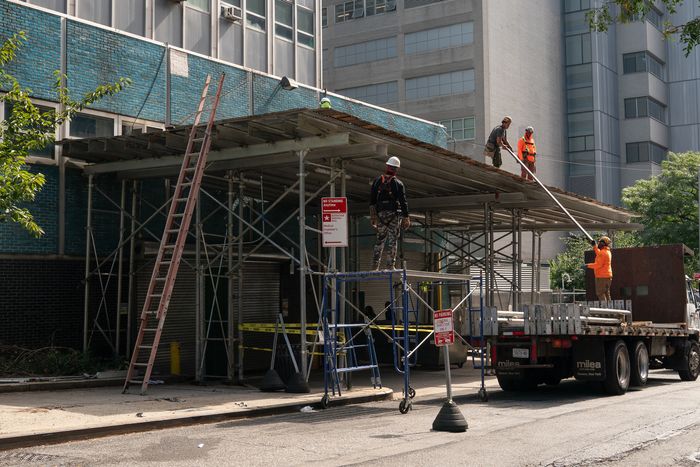The City Council unanimously passed a package of bills on Wednesday to reduce the presence of sidewalk sheds, an issue that has united politicians including Keith Powers, Mark Levine, and Eric Adams.
Photo: William Alatriste/NYC Council Media Unit
Alvin Bragg. Eric Adams. Gale Brewer. Mark Levine. Keith Powers. If there’s any platform that unites New York City officials (and community groups and business owners), it’s a stand against sidewalk sheds, the green plywood and metal structures covering mile after mile of city walkways. There are currently more than 8,500 active sidewalk sheds totaling over 2 million linear feet, or roughly the distance from here to Montreal. They “grow like a fungus,” filmmaker John Wilson once said in an episode of How to With John Wilson. But unlike a fungus, they seem to have taken a permanent hold on the landscape, like the shed outside the former P.S. 64 building in the East Village, first put up in 2010. On Wednesday, the City Council unanimously passed a package of bills to reduce their presence, and perhaps make them a little easier on the eyes too. “For too long, our city has been covered in over 400 miles of ugly, dingy scaffolding that impacts the experience of everyday New Yorkers, small-business owners, and people coming to visit our city,” says Powers, a Democratic councilmember representing Manhattan’s east side and one of the sponsors of the bills. “It doesn’t have to be this way.”
What was intended as a safety precaution following the 1979 death of a Barnard student struck by falling debris has evolved into a lucrative, billion-dollar industry, with Crain’s previously reporting that New York City building owners were paying $1.2 billion a year to build and maintain the structures. Of course, construction sites should have them, but many of the sheds are also erected by landlords complying with the decades-old Local Law 11, which requires them to have their building façades inspected every five years. Anti-shed advocates say it’s simply cheaper for some building owners to keep the sheds up indefinitely rather than finish the requisite repairs, according to Gothamist. That may explain why sheds today are up for an average of 511 days, with more than a half-dozen dating back to Barack Obama’s first term in the White House.
The Adams administration last year celebrated the removal a sidewalk shed that was first erected in 2009 outside the Office of the Chief Medical Examiner in Kips Bay — at the time the oldest shed outside a city-owned building.
Photo: Barry Williams/New York Daily News/Tribune News Service/Getty Images
So what’s changing now? For one, how long sheds can stay up. One of the bills introduced by Powers, who also is running for Manhattan borough president, slashes the permit length of new sidewalk sheds from one year to just three months. While permits can be renewed, the legislation incentivizes actually finishing the repairs by penalizing landlords up to $6,000 a month if they can’t prove they are doing work that requires the sheds, like construction, or are delayed by other issues like financial hardship. Another bill sponsored by Powers allows the Buildings Department to increase the time between façade inspections from the current five-year window to as many as 12, while delaying mandatory inspections for new buildings from every five years to eight.
As for the look of the sheds, the City Council also passed bills that require more lighting in the sheds and for them to be raised higher, and that allow them to be painted colors other than the mandatory hunter green, such as white, metallic gray, or other colors matching a building’s exteriors. But beyond these small cosmetic fixes, the city will also require the Department of Buildings to study better designs for the sheds and submit them by the end of September.
With these new laws and other reforms potentially on the way, that might make this year’s Sheddie Awards, which recognized the west side’s “most egregious scaffolding projects,” the first and last. Earlier this month, State Senator Brad Hoylman-Sigal and Assemblyman Micah Lasher, both of whom represent the Upper West Side, suited up and bestowed that honor to six buildings that neighbors had voted on in a number of categories (the top prize, of course, went to 51 West 86th Street, also a longstanding target of Brewer, who represents the Upper West Side in the City Council). Both lawmakers used the event to stump for bills they had introduced in Albany that would reward property-tax rebates to landlords who quickly removed their scaffolding and penalize those who let the structures languish. “Like so many New Yorkers, I simply hate sidewalk sheds, and have watched despondently as they’ve grown like weeds on the west side,” said Lasher. “Let’s get the damn scaffolding down!”


